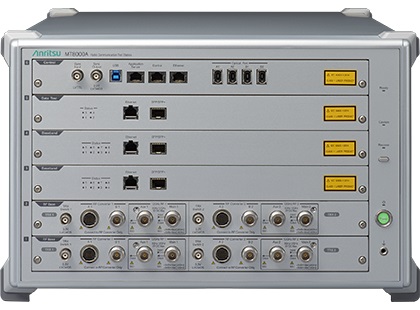Anritsu Corporation is pleased to announce the start of sales of its popular Radio Communication Test Station MT8000A with upgraded 5G Protocol Test functions now supporting 3GPP TS 38.521-4 B.1/B.2 V15.0.0-compliant 5G NR channel (TDL) model tests using NR Fading software implementing built-in baseband fading tests.
A fading test simulates the actual radio-wave propagation environment required for development of mobile devices. The previously required external 5G RF fading simulator has been implemented as an internal fader in the MT8000A, supporting either 2CC 4×4 MIMO tests with one MT8000A unit, or 8CC 2×2 MIMO tests with two units.
As a result, Protocol Test set-up in a fading environment is simpler than previous solutions while elimination of external test equipment as well as compatibility with existing protocol functions helps cut development costs.
Development Background: 5G services have started already in N. America from late 2018, and more rollouts are expected from 2019 centered mainly on advanced economies. As a result, 5G mobile-terminal development is growing rapidly.
Mobile-terminal development requires 3GPP-compliant testing and evaluation for assured interoperability, and these test contents are not limited to static communications protocols and RF evaluations between mobiles and base stations, but also include RRM tests simulating a moving mobile unit, as well as evaluations, etc., in a fading environment.
Anritsu developed this solution for mobile-terminal vendors requiring efficient tests with good cost-performance covering a wide range of conditions.
Product Outline
Radio Communication Test Station MT8000A
The MT8000A is an all-in-one test platform for RF, Protocol, and Beam tests, as well as for beam-forming evaluations. In addition to supporting functions for simulating base-station NSA and SA modes required for development of 5G chipsets and terminals, it also supports the latest technologies, such as 4×4 MIMO for increasing data transmission speeds in the Sub-6 GHz band as well as 8CC for implementing wideband mmWave.
Moreover, it covers the key frequency bands used by the first 5G services, such as the Sub-6 GHz band (FR1) frequencies of 2.5 GHz, 3.5 GHz, 4.5 GHz, etc., and the mmWave band (FR2) frequencies of 28 GHz, 39 GHz, etc.
Additionally, the easy-to-use interface coupled with RF measurement software supporting a full range of test parameter settings plus NR fading software for simulating 3GPP fading propagation conditions make it easy to configure a reasonably priced cost-effective test environment.
To learn more, visit: www.anritsu.com








